Stay Up to Date
Submit your email address to receive the latest industry and Aerospace America news.
AIAA Announces Its Class of 2022 Honorary Fellows and Fellows
AIAA has selected its newly elected Class of 2022 Honorary Fellows and Fellows.
Honorary Fellow is the highest distinction conferred by AIAA and recognizes preeminent individuals who have had long and highly contributory careers in aerospace and who embody the highest possible standards in aeronautics and astronautics. In 1933, Orville Wright became the first AIAA Honorary Fellow. Today, AIAA Honorary Fellows and AIAA Fellows are the most respected names in the aerospace industry.
The 2022 Honorary Fellows are:
Roger A. Krone, Leidos
Salvatore “Tory” Bruno, United Launch Alliance
Wesley L. Harris, Massachusetts Institute of Technology
AIAA confers the distinction of Fellow upon individuals in recognition of their notable and valuable contributions to the arts, sciences or technology of aeronautics and astronautics. Nominees are AIAA Associate Fellows.
The 2022 AIAA Fellows are:
Maruthi Akella, University of Texas at Austin
Erian A. Armanios, University of Texas at Arlington
Erik P. Blasch, Air Force Office of Scientific Research
Terry J. Burress, Lockheed Martin Corporation
J. Russell Carpenter, NASA Goddard Space Flight Center
Louis N. Cattafesta III, Florida A&M University – Florida State University
William J. Devenport, Virginia Polytechnic Institute and State University
John J. Dong, The Boeing Company
Thomas L. Frey Jr., Lockheed Martin Aeronautics
James W. Gregory, Embry-Riddle Aeronautical University
Yanping Guo, Johns Hopkins University Applied Physics Laboratory
Marillyn A. Hewson, Lockheed Martin Corporation
Felix R. Hoots, The Aerospace Corporation
Naveed Hussain, The Boeing Company
James K. Kuchar, MIT Lincoln Laboratory
Robert M. Lightfoot Jr., Lockheed Martin Space
Gen. Lester L. Lyles, U.S. Air Force (retired)
Anastasios S. Lyrintzis, Embry-Riddle Aeronautical University
Sergey O. Macheret, Purdue University
Sandra H. Magnus, Georgia Institute of Technology
Dimitri J. Mavriplis, University of Wyoming
Lawrence M. Robertson III, U.S. Air Force Research Laboratory
Mary M. Roybal, Raytheon Missiles & Defense
Walter H. Rutledge, CENTRA Technology, Inc., A PAE Company
Amanda R. Simpson, Airbus Americas
Mark N. Sirangelo, University of Colorado Boulder
Grant H. Stokes, MIT Lincoln Laboratory
Afzal Suleman, University of Victoria
For more information on the AIAA Honors Program, contact Patricia A. Carr at [email protected].
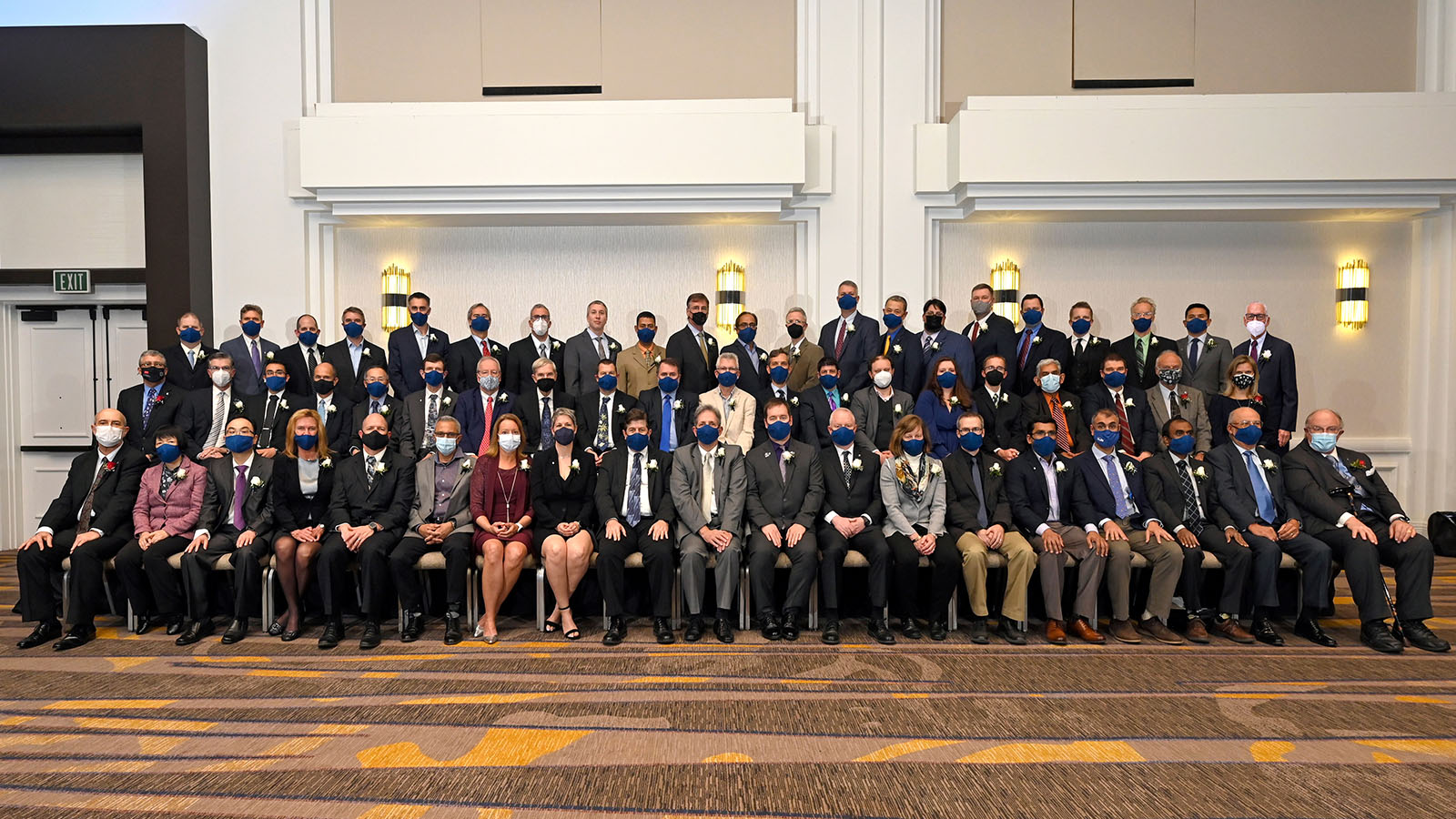
AIAA Associate Fellows Inducted
The Class of 2022 AIAA Associate Fellows were inducted at the AIAA Associate Fellows Dinner and Induction Ceremony on 3 January at the Manchester Grand Hyatt San Diego in conjunction with AIAA SciTech Forum.
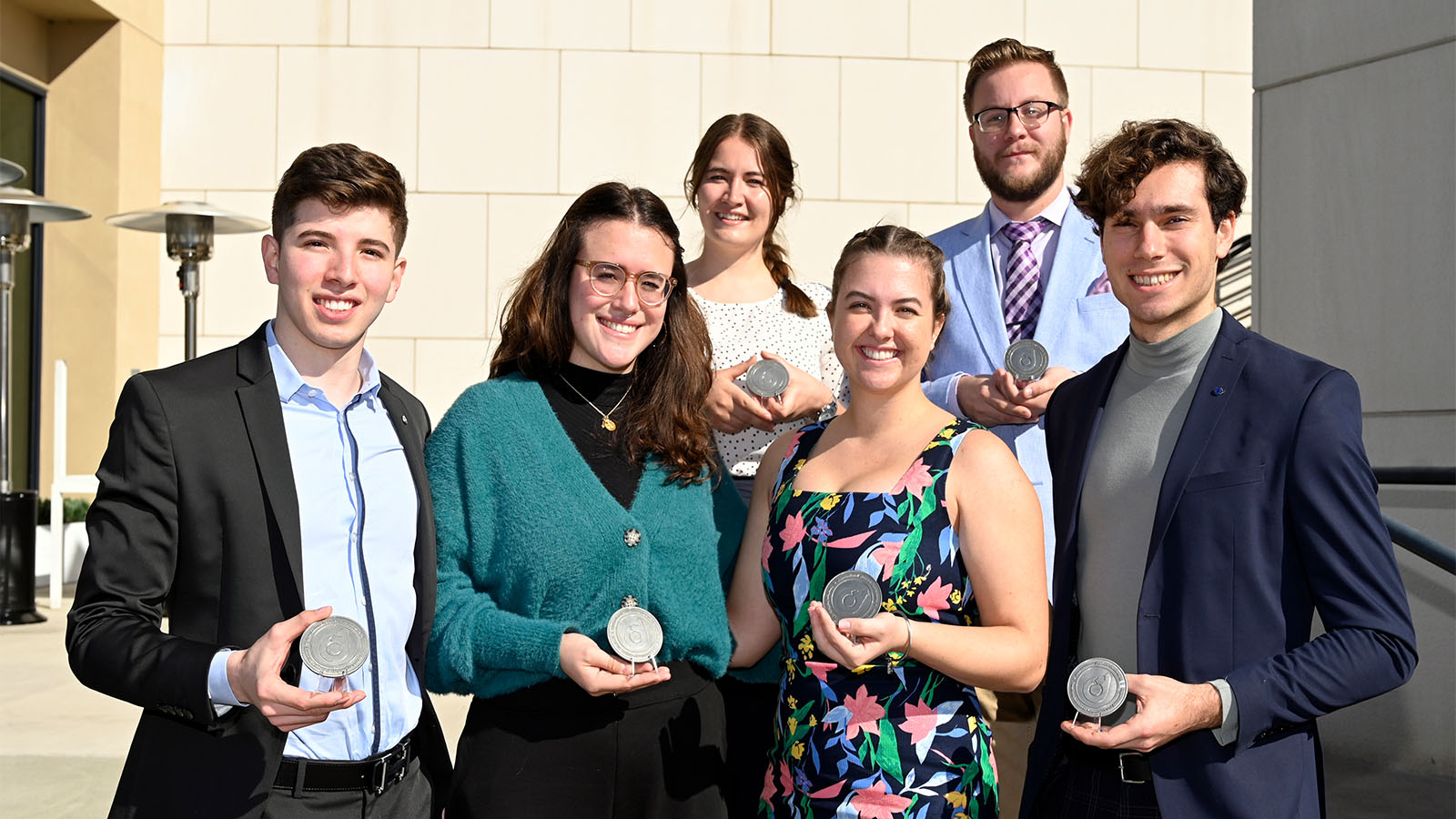
2022 International Student Conference Winners Announced
The AIAA International Student Conference took place on 3 January in conjunction with the AIAA SciTech Forum. Students who won first place at one of the 2021 AIAA Regional Student Conferences presented their papers at this professional technical conference, which offers students a chance to showcase their original research at an event where they can also network with potential employers and colleagues. The winners were announced at an awards breakfast on 4 January, where Lockheed Martin Fellow Mike Buonanno provided the keynote address to the student attendees.
The winners are:
Undergraduate Category
“Novel Optical Diagnostics for the Study of Shock Separation in Rocket Nozzles,” by Meaghan Munro, Monash University (Melbourne, VIC, Australia)
Master’s Category
“Preliminary Adaptation of Speech Source Localization Algorithm for Reduced Bandwidth of Interest in Tonadic Infrasound Signals,” by Brandon White and Ujjval Patel, Oklahoma State University (Stillwater, OK)
Team Category
“Design of a Modular Orientable Electrodynamic Shield for Lunar Dust Mitigation,” by Luis Pabon Madrid, Polina Verkhovodova, Malcom Tisdale, Isabella Dula, Kaila Coimbra, Tanmay Gupta, Leah Soldner, Rithvik Musuku, and Soon-Jo Chung, California Institute of Technology (Pasadena, CA)
Information about the student conferences can be found at aiaa.org/get-involved/students-educators/student-conferences, or by contacting Lindsay Mitchell at [email protected]. Thank you to Lockheed Martin for sponsoring the event.
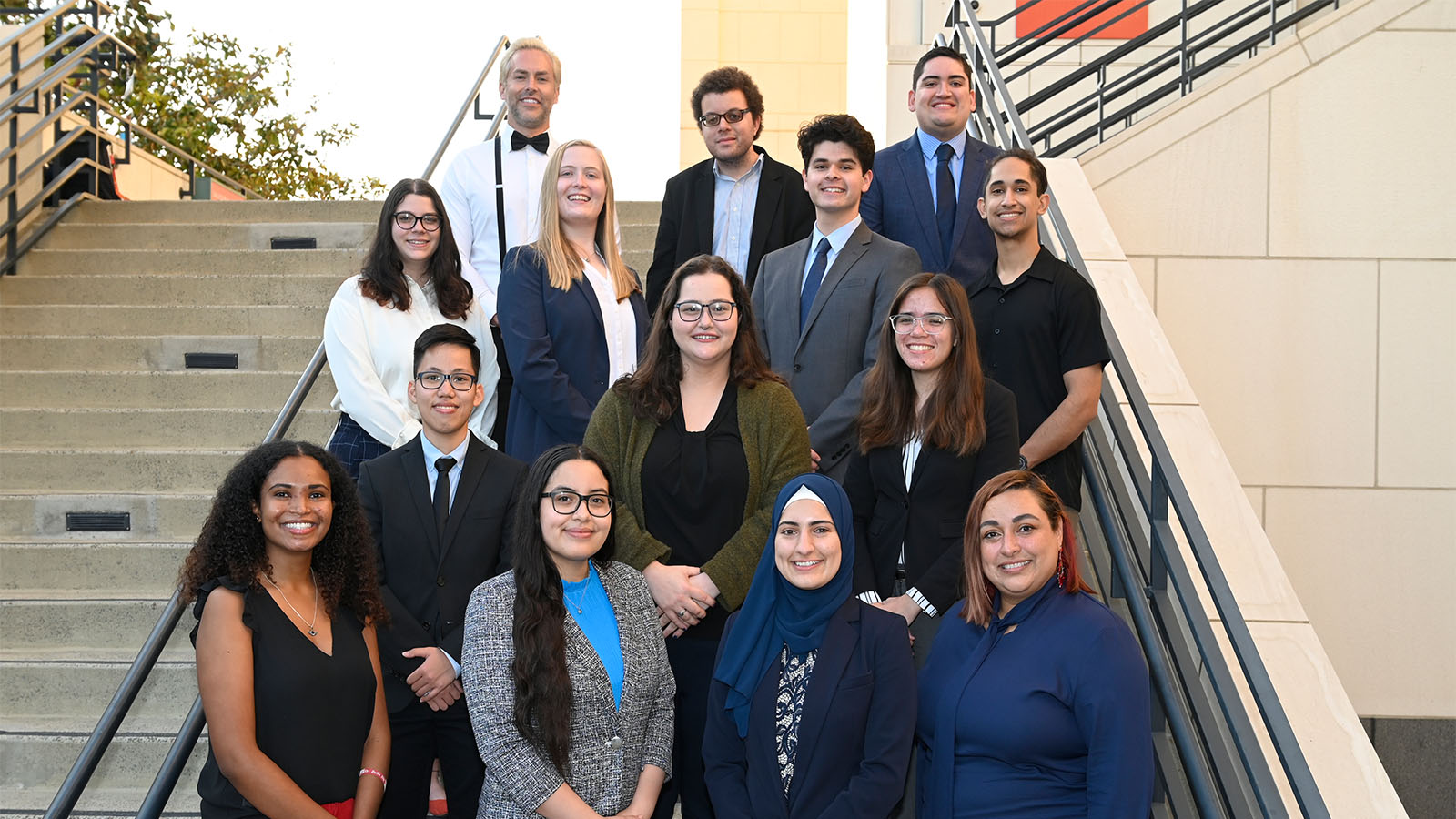
Diversity Scholars at AIAA SciTech Forum
Fourteen AIAA Diversity Scholars attended AIAA SciTech Forum, 3–7 January 2022, in San Diego. The scholars attended the plenary and Forum 360 sessions, the student awards breakfast, and Rising Leaders in Aerospace events, as well as other special sessions targeted specifically at the scholars.
The AIAA Diversity Scholarship was created to provide networking and engagement opportunities at forums to students from backgrounds that are traditionally underrepresented in the industry. These students receive round-trip airfare, a complimentary hotel stay, forum registration, and additional targeted programming that may help them succeed in the aerospace industry. This program is a collaboration of the AIAA Foundation and The Boeing Company.
Diversity scholarships will be offered at the 2022 AIAA AVIATION Forum and 2022 ASCEND event. We encourage applications from students in all disciplines with an interest in aerospace, including but not limited to STEM fields, communications, law, industrial design, journalism, and political science. Please visit aiaa.org/get-involved/committees-groups/Diversity-and-Inclusion/Diversity-Scholars-Program for more information.
Call for Papers for F. Landis Markley Memorial Virtual Collection
On 5 December, the guidance, navigation, and control community lost one of its most influential and well-regarded figures. The clear and rigorous body of work that AIAA Fellow Dr. F. Landis Markley contributed to our field has been foundational to the development of the theory and practice of attitude determination, as well as many other areas of spacecraft dynamics and control. The Journal of Guidance, Control, and Dynamics (JGCD) will dedicate a Virtual Collection in his honor. The focus is specifically targeted to aspects of aerospace estimation, dynamics, and control applications to which Dr. Markley contributed, with a particular focus on spacecraft attitude applications.
For questions on the suitability of a manuscript and other questions related to the Virtual Collection, please contact the Editors for this Virtual Collection, Dr. John L. Crassidis ([email protected]) and Dr. Russell Carpenter ([email protected]). For general questions regarding JGCD, contact Prof. Ping Lu, Editor-in-Chief ([email protected]). If you already have a manuscript under review by JGCD and would like to have it considered for the Virtual Collection, please contact Prof. Lu with a copy of the request sent to Dr. Crassidis and Dr. Carpenter.
To ensure consideration for inclusion, please submit papers no later than 31 October 2022 at https://mc.manuscriptcentral.com/aiaa-jgcd. Authors must select the Virtual Collection “F. Landis Markley Memorial” during submission. Both Full-Length Papers and Engineering Notes are welcome. If a manuscript is deemed not in scope for the Virtual Collection, the author will be notified and the manuscript will be considered by JGCD as a regular submission. The full call for papers can be found at: arc.aiaa.org/sda/1180/Markley_JGCD.pdf.

Making an Impact: AIAA Members Bring Hands-On Activities to High Tech High School
By Craig Merrett
On 5 January, 18 AIAA members from the Aerodynamics, Structures, and Structural Dynamics Technical Committees (TCs) and the local AIAA San Diego Section visited grade 9 students at High Tech High School during the 2022 AIAA SciTech Forum in San Diego. Also visiting were members from the AIAA STEM K-12 Outreach Committee and the AIAA Diversity and Inclusion Working Group. Over 100 students tried hands-on demonstrations to learn some of the basic principles behind aerospace engineering. The Aerodynamic TC’s small wind tunnel with smoke visualization illustrated how air flows over an airplane, and students created the Coanda effect using straws and a ping-pong ball. The Structures TC’s wooden models of a wing revealed the effects of stiffness and geometry on the bending and twisting of wings.
The Structural Dynamics TC marked their 10th year of visiting schools as part of AIAA SciTech Forum with exciting experiments, including a Ruben’s tube visualizing acoustic waves created by music. Students also used tuning forks to experiment with resonance, and Chladni plates to show mode shapes using sand. The students were given the opportunity to chat one-on-one with the engineers about their careers and the exciting technologies they work on. We thank High Tech High physics teacher Amilio Aviles for coordinating this visit.
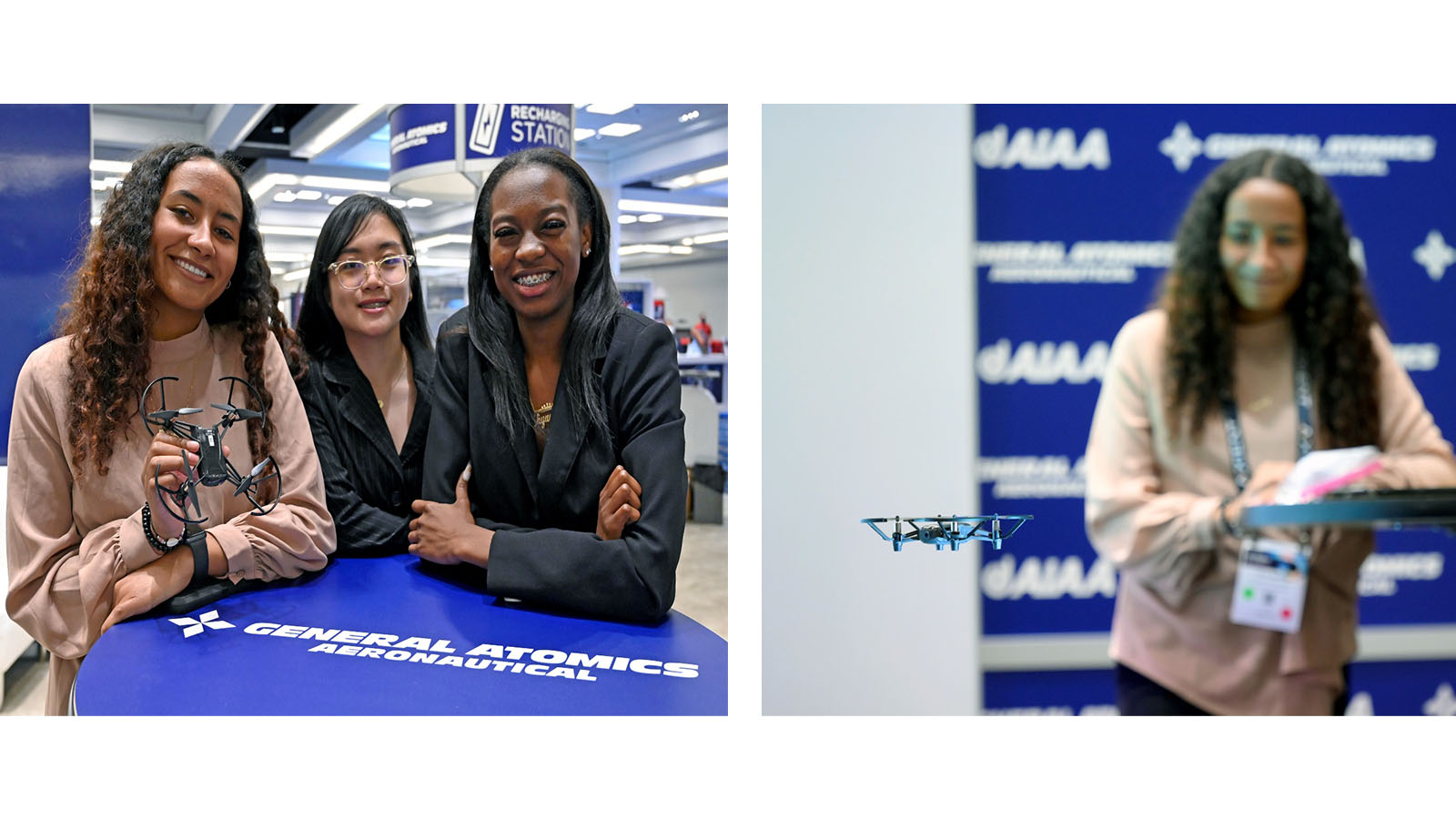
Making an Impact: Girls Take Flight—Drone Program Returns to AIAA SciTech for HUB Session
Girls Take Flight is an innovative program for 10th and 11th grade high school girls that provides hands-on experience building and flying drones and explores their real-world uses. Students become FAA-certified drone pilots. Under the leadership of Jim Stone and Vanesa Dominguez, three students, Fatima Laugo, Shyanne Smith, and Trinity Watkins, presented a HUB session on the drone program and demonstrated their knowledge of Python to program a Tello drone. The program is run by nonprofit Elementary Institute of Science (EIS) in San Diego.
After the HUB presentation the students met with exhibitors and were provided with the opportunity to tour a Gulfstream G500.

Making an Impact: Go For Launch! Student Program Update at AIAA SciTech Forum
Long-time AIAA advocate and educational partner Higher Orbits inspires the next generation of STEMists and Explorers with its Go For Launch! Program. In a HUB session, three program alumni, Abby Maltese, Sophie Crowder, and Claire Pickerel, described their Go For Launch! experience, their STEM pursuits, and student science in space.
Abby Maltese was part of the winning team in the Go For Launch! Cygnus Series. Her team’s experiment focuses on the evaluation of self-healing materials in microgravity. This experiment launched aboard the NG-10 flight on 17 November 2018, and the students are still analyzing the data.
For more information about how to get involved with AIAA and make an impact please visit aiaa.org/foundation or contact Alex D’Imperio, [email protected].
2022 AIAA Key Issues And Recommendations
Aerospace is Technology. Aerospace is Innovation. Aerospace is Jobs.
The U.S. aerospace and defense (A&D) industry – which comprises Aeronautics, Space, and associated Research and Development (R&D) activities – is a multi-trillion-dollar enterprise. It supports millions of jobs domestically and produces out of this world technology innovations built upon our world-class, but aging infrastructure. The A&D industry is critical to our nation’s well-being, providing major contributions to education, economic prosperity, quality of life, national defense, and homeland security. In this new decade, and as the COVID-19 pandemic persists, it is critical that substantial action be taken to address the needs of the industry and the complex global economic, technological, and military competitions that are poised to affect the United States’ future as an international leader and technological and economic powerhouse.
The A&D industry, consisting of the private sector, government agencies, and academia, currently is, and will continue to be, pivotal in addressing the needs of our nation. Mitigating climate change through developing technologies that reduce carbon emissions and ensuring responsible use of outer space for a sustainable future both on and off the planet are critical to our future. The A&D industry provides opportunities for individuals from all races, nationalities, and socioeconomic statuses. Together we tackle the complex challenges associated with improving our society and defending our way of life, driving our innate desire to explore and be curious, working toward a greener future, and keeping outer space accessible to all.
AIAA – the world’s largest aerospace professional society – urges decision makers to enact and support policies that will provide for sustainment and growth of all elements of the A&D industry. The industry continues to be critical to the security and prosperity of the United States, and the actions taken (or missed) are pivotal to maintaining a robust, world-leading A&D sector and will affect the nation and our community for many years to come.
AIAA seeks support from policymakers to address the following key issues:
• Accelerate the establishment of policies that facilitate the commercialization of space for U.S. technological competitiveness, economic growth, and national security benefits
• Support the growth, evolution, and diversification of the 21st-century workforce to fill the job needs in the industry
• Support long-term, robust investments in research and technologies that drive innovation and sustainability across the A&D industry
• Support initiatives with associated funding for the recovery and advancement of the A&D industry – including workforce, infrastructure, and technology advancements
The Commercialization of Space Economic Growth And National Security
The commercialization of space is critical for U.S. economic growth and national security. The space economy was estimated at over $350 billion in 2019, and in 2020 over $7.6 billion was invested in space startup companies. With these investments at an all-time high, the pace of innovation and technology development is literally skyrocketing. Necessary to enabling this economy, which is fueled by private industry and advances U.S. technological leadership and competitiveness, is defined government needs and priorities, a skilled workforce, and research and development funding to transition technologies for national security missions. However, with multiple nations and companies seeking to operate in space, challenges exist for establishing norms of behavior – for space traffic management, responsible use of the communication spectrum, and enabling Earth orbit operations through orbital debris mitigation. The United States must act quickly and decisively to demonstrate leadership in all these areas – taking the initiative to act first and set global precedents for norms of behavior for the responsible use of outer space.
Recommendation: Provide guidance and direction to this nascent space industry to incentivize and sustain economic growth and promote U.S. leadership and national security.
Growing, Evolving, and Diversifying the 21st-Century Workforce
The future of the A&D industry relies on a properly skilled, qualified, and fully staffed workforce. This workforce, which is over 2 million strong with salaries 41% higher than the national average, forms the A&D industrial base backbone. There is currently fierce competition among employers for qualified technical talent, exacerbated by large numbers of currently unfilled jobs. Despite numerous efforts over the past decade to make significant advancements to diversify the workforce, the needle has only moved a small amount2. A diverse and fully inclusive pipeline – including K-12 through trade schools and colleges and universities, as well as accommodating international students – must produce qualified workers in sufficient numbers to fill the range of skills necessary for our industry, including advanced manufacturing. Technology is advancing at an exponential rate; therefore, company leaders and policymakers must afford the workforce with continuous learning and growth opportunities to meet the current and forecasted hiring demand in a field that literally has no ceilings. Challenges remain for employers at all levels of government, industry, and academic institutions and failing to educate, attract, and retain top talent is likely the greatest threat to maintaining U.S. leadership and global competitiveness.
Recommendation: Support development of a diverse aerospace workforce for all skill types and stages of career to advance learning commensurate with technology and product advancement, such as incentives for K-12 STEM teachers, H-1B visa reform, and legislation that enhances the pipeline of STEM-competent workers.
Research and Technologies that Drive Innovation and Sustainability
The United States must continue to make research and development (R&D) investments that will result in future innovative and sustainable aviation and space products and processes. This investment is required to sustain and grow the significant positive economic impact that the A&D industry has across all segments of the economy, while ensuring national security and defense readiness. Keys enablers are development and sustainment of state-of-the-art facilities – including experimental and computational R&D capabilities – combined with predictable and stable funding to address current and emerging threats and technologies such as hypersonics and climate change. Aviation connects the world – ultimately increasing national and global productivity, economic opportunity, and quality of life. Space inspires us, fuels curiosity and learning, and benefits life on Earth – exploration of the solar system, understanding our universe, and providing critical infrastructure for telecommunications, navigation, and surveillance. A robust pipeline of research, technology maturation, and product/process development – enabled by a key funding and foundational infrastructure – is critical to the future quality and growth of the aviation and space economies.
Recommendation: Support robust, long-term funding for federal research and technology initiatives in aeronautics and space, including necessary infrastructure, to ensure U.S. leadership in critical areas such as artificial intelligence, advanced air mobility, cybersecurity, hypersonics, and robotics.
Recovery and Advancement from COVID-19 Pandemic Effects
The A&D industry was vital to the nation during the first year of the COVID-19 pandemic, e.g., ventilator and PPE production and vaccine distribution. Nearly two years later, the A&D industry continues to be severely impacted – including the workforce, infrastructure, and technology advancements. During calendar year 2020 and the first half of 2021, it was reported that more than half of the A&D workforce was working remotely. Complexities still exist for workers who can perform their duties virtually versus essential workers who are required to be on-site. Despite government and defense spending remaining stable during the pandemic, the aerospace sector – specifically jobs and technology advancement – has been negatively impacted by the pandemic’s economic fallout. It is imperative that the government continue to provide stable and predictable funding for government programs and organizations as we rebuild our aging infrastructure (including virtual collaboration tools), support and grow our workforce while ensuring COVID-19 safety measures, and develop technologies that advance the state of the art and fuel economic growth such as achieving net-zero carbon emissions by 2050.
Recommendation: Create initiatives and provide funding for the recovery and advancement of the A&D industry – including workforce, infrastructure, and technology advancements.
Take Part in the 24th AIAA Congressional Visits Day
Registration is now open for any United States-based AIAA member who would like to participate in the Institute’s 24th annual Congressional Visits Day (CVD) program, to be held the week of 14 March. Given the health and travel concerns related to the ongoing coronavirus pandemic, along with the strict protocols to access the Capitol Complex, this year’s event will once again be entirely virtual.
Your contributions to this upcoming event will be invaluable as the aerospace and defense (A&D) industry and its supply chain continue to be impacted by the prolonged pandemic. We will call on lawmakers to address the ongoing needs of the industry, including the following key issues:
• Ensuring technological competitiveness, commercialization, and behavioral norms in the space economy
• Growing, evolving, and diversifying the 21st-century workforce
• Investing in research and technologies that drive innovation and sustainability across the A&D industry
• Providing initiatives for recovery from the COVID-19 pandemic to ensure that the United States retains global aerospace leadership
Find out more information and register at: aiaa.org/advocacy/congressional-visits-day.
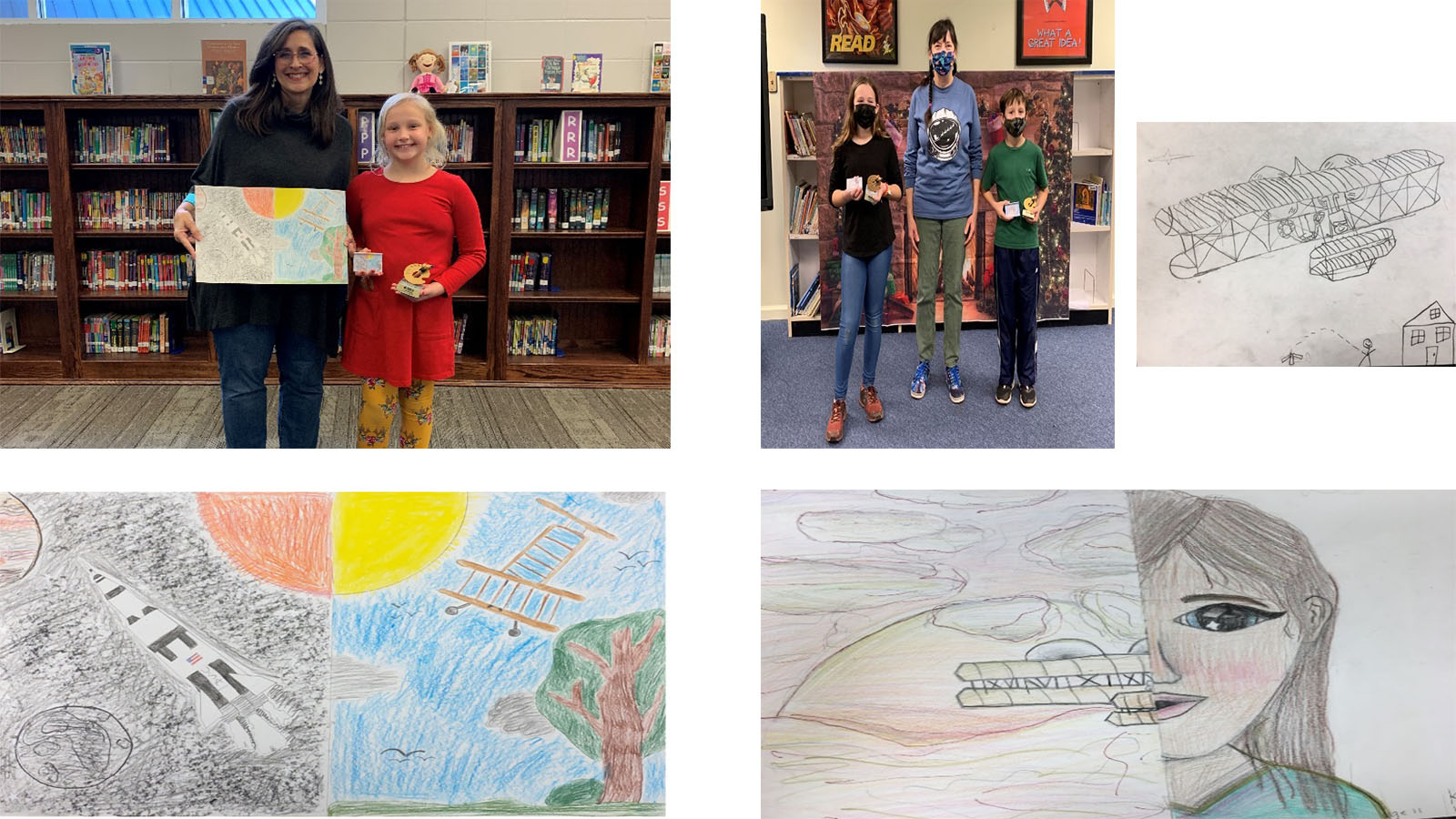
Students Commemorate Wright Brothers’ First Flight with Imaginative Drawings
By Robin Osborne, Pre-College Outreach Officer, AIAA Greater Huntsville Section
Three very talented students were recently recognized by the AIAA Greater Huntsville Section (GHS) for their stellar drawings commemorating the 118th anniversary of the Wright Brothers’ historic first flight. Annalie Kastning was the 1st place winner out of the 19 entries from Monrovia Elementary. Kennedy Craft and Cody Daniel were the 1st- and 2nd-place winners, respectively, out of 42 entries from Horizon Elementary School. These drawings were among a record-breaking 61 entries for this year’s annual AIAA GHS drawing contest honoring the Wright Brothers.
The students were surprised with personalized trophies at their schools on the morning of 17 December by AIAA GHS members Robin Osborne and Len Naugher, who served as the lead judge for the contest. The Monrovia students were sponsored by AIAA Educator Associate Sherrie Frady, 2021 AIAA GHS Konrad Dannenberg Educator of the Year, and the Horizon students were sponsored by AIAA Educator Associate Elizabeth Bero, recipient of the 2020 AIAA Foundation Educator Achievement Award.
Congratulations to the students on their inspiring drawings, as well their teachers, for their outstanding service to education and promotion of math and science in the Huntsville and Madison communities.

AIAA Fellow Vanderplaats Died in November
Dr. Garret N. (Gary) Vanderplaats died 17 November 2021. He was 77.
Dr. Vanderplaats received an M.S. in Civil Engineering from Arizona State University in 1968, and his Ph.D. in Structural Mechanics from Case Western Reserve University in 1971. He worked as a research scientist for eight years at NASA Ames Research Center where he managed the conceptual aircraft design MDO program, ACSYNT. He taught for five years at the Naval Postgraduate School, and in 1984 joined the faculty at University of California, Santa Barbara as professor of Mechanical Engineering, where he twice received the outstanding professor award in Mechanical Engineering.
He founded Engineering Design Optimization, Inc. (later renamed Vanderplaats Research & Development and then OmniQuest) in the mid 1980s and served as CEO until 2020 and chairman until his passing. The company provides a suite of structural and multidisciplinary design optimization software products.
An AIAA Fellow, Dr. Vanderplaats was involved with the AIAA Multidisciplinary Design Optimization Technical Committee (1990–1994) and was the recipient of the 2002 AIAA Multidisciplinary Design Optimization Award.
Dr. Vanderplaats was known as one of the founding fathers of practical structural and multidisciplinary design optimization in the United States. He pioneered many techniques in optimization. While at NASA, he developed the Modified Method of Feasible Directions optimization algorithm, implemented in his widely used CONMIN and ADS software. He introduced second order approximation methods that drastically improved the convergence of structural optimization, including the most notable example, the force approximation. He developed many optimizers in his career, including DOT, BIGDOT, and DSCDOT. His optimizers have been embedded in countless programs around the world. He developed and directed the development of tools to make optimization applications user friendly: COPES, DOC, VisualDOC (now Iliad).
A pioneer of commercial finite-element structural optimization software, Dr. Vanderplaats guided the development of SOL 200 for MSC Nastran, as well as his own finite-element structural optimization software, GENESIS.
Over the years, Dr. Vanderplaats published numerous papers on optimization, MDO and Structural Optimization. He authored two books, Numerical Optimization Techniques for Engineering Design: With Applications and Multidisciplinary Design Optimization, that have served to teach optimization to many generations of students.
AIAA Fellow Markley Died in December
F. Landis Markley died 5 December. He was 82 years old.
Dr. Markley was educated at Cornell University and the University of California at Berkeley, receiving his Ph.D. in elementary particle physics in 1967. After a year as a National Science Foundation postdoctoral fellow in the Department of Physics and Astronomy at the University of Maryland, College Park, he accepted a position as Assistant Professor of Physics at Williams College from 1968 to 1974.
He then served on the technical staff of Computer Sciences Corporation (1974–1978), and in the Space Systems Division of the Naval Research Laboratory (1978–1985). He spent 25 years at NASA Goddard Space Flight Center, until he retired in 2010. At Goddard, Dr. Markley contributed to control systems for more than 20 missions, including the Hubble Space Telescope, the Wilkinson Microwave Anisotropy Probe, several of the Geostationary Environmental Satellite missions, and the James Webb Space Telescope.
Dr. Markley was particularly prominent in the development of innovative extensions, analytical tools, and operational software for the application of Kalman filtering, batch techniques, and covariance analysis to attitude estimation. He authored many classic papers in spacecraft attitude estimation, dynamics, and control. Dr. Markley was one of the principal contributors to the book Spacecraft Attitude Determination and Control (1978), which is a vital resource for practicing engineers to this day. In 2014, he was first author of the book Fundamentals of Spacecraft Attitude Determination and Control, which has become essential to the education of many astronautical engineers.
Elected a Fellow of AIAA and the American Astronautical Society, Dr. Markley also was recognized with numerous awards, including the Moe Schneebaum Award, two NASA Exceptional Service Medals, the 1998 AIAA Mechanics and Control of Flight Award, the 2005 AAS Dirk Brouwer Award, and the 2008 AIAA Guidance, Navigation, and Control Award.
The author of numerous publications, he was also an Associate Editor of the AIAA Journal of Guidance, Control, and Dynamics (JGCD) from 1992 to 1994. In memory of Dr. Markley, JGCD will dedicate a Virtual Collection in his honor; learn more at arc.aiaa.org/sda/1180/Markley_JGCD.pdf.
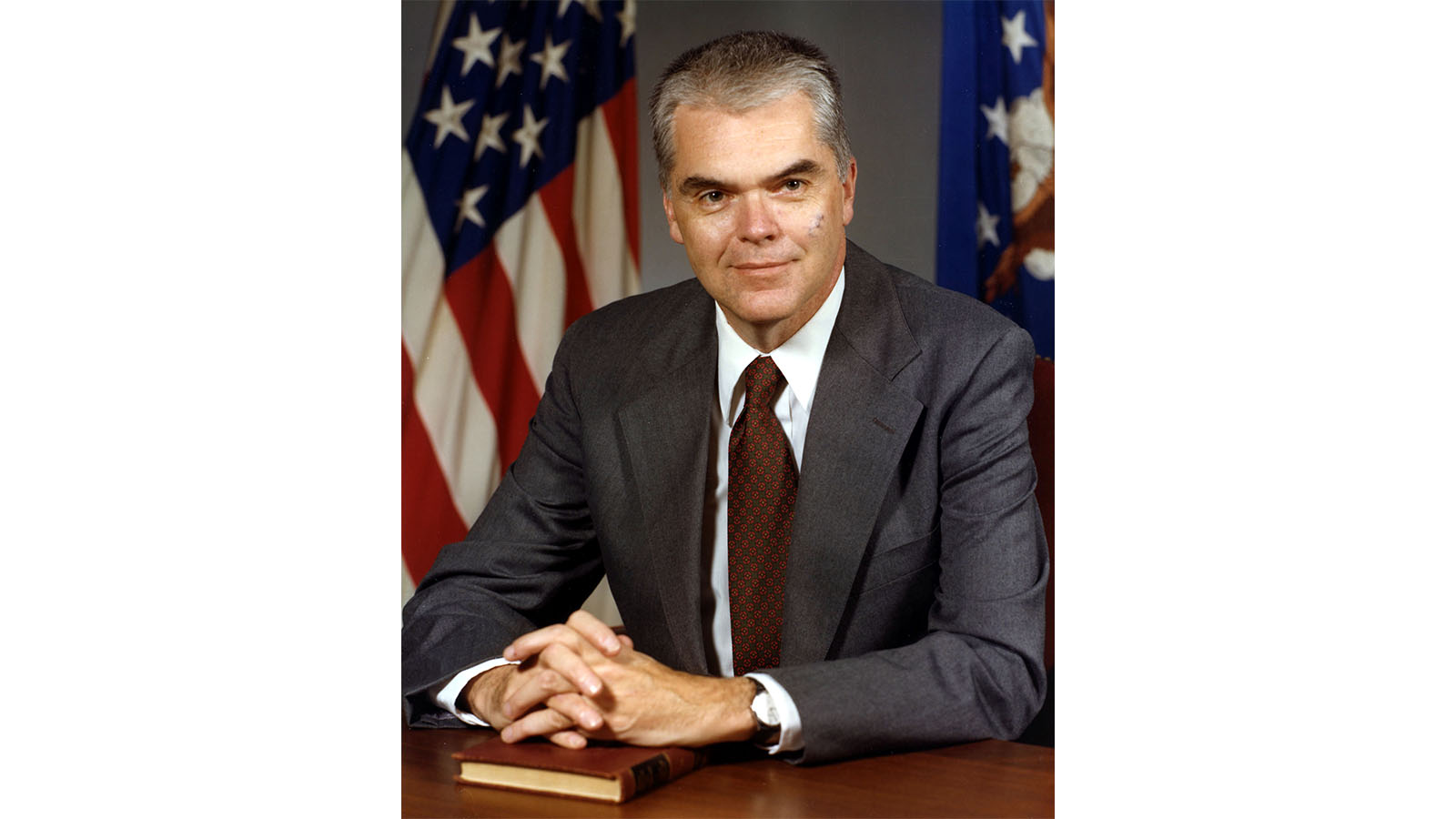
AIAA Honorary Fellow Mark Died in December 2021
Aerospace engineer Hans Mark died on 18 December. Mark was 92.
Born in Mannheim, Germany, Dr. Mark escaped from Austria with his family in 1940. After settling in the United States, Dr. Mark received his bachelor’s degree in physics from the University of California, Berkeley in 1951. He earned his Ph.D. in physics from MIT in 1954.
He held a number of research and teaching jobs at Boston University, MIT, Stanford University, and the University of California. After finishing his graduate studies, Dr. Mark was a research associate at MIT and acting head of the Neutron Physics Group, Laboratory for Nuclear Science until 1955. He returned to Berkeley as a research physicist, and then worked at the university’s Lawrence Radiation Laboratory in Livermore (1960–1964). In 1964, Dr. Mark became chair of Berkeley’s department of nuclear engineering while directing the Berkeley Research Reactor.
In 1969, he was named director of NASA Ames Research Center. As director Dr. Mark managed the center’s research and applications efforts in aeronautics, space science, life science, and space technology. He also was a lecturer in applied science at the University of California, Davis (1969–1973).
In the late 1970s and early 1980s, he held positions including as secretary of the Air Force, director of the National Reconnaissance Office, deputy administrator of NASA, and director of Defense Research and Engineering at the Pentagon. Dr. Mark devoted much of his career to nuclear deterrence during the Cold War, including the development of secret technology for spying and enhancing America’s nuclear capability.
He moved Austin in 1984 when he was named chancellor of the UT System. He also taught aerospace engineering in UT’s Cockrell School of Engineering.
Over the years Dr. Mark had also served as a consultant for the Institute for Defense Analyses,the National Science Foundation, the U.S. Air Force Scientific Advisory Board, the vice president of the United States, and the Defense Science Board.
In 2008, the Space Foundation awarded Dr. Mark with the General James E. Hill Lifetime Space Achievement Award, and in 2012, the Air Force Space Command awarded him the Air Force Space and Missile Pioneers Award. In 2011, he was recognized with the AIAA von Kármán Lectureship in Astronautics.
AIAA Fellow Patton Died in December
Robert J. (Bob) Patton, aeronautical engineer and retired Senior Vice President of Vought, died on 26 December 2021. He was 99 years old.
Mr. Patton began his studies at the University of Michigan before serving for three years in the Army Signal Corps during World War II. He returned to the University of Michigan to complete graduate school (MSE, aero) in 1947. He joined Consolidated (subsequently General Dynamics) as an aerodynamicist, and worked on the B-36, B60, B-58, RB-57F, and F-111, and was the FB-111A Program Director.
In 1971 Mr. Patton became Chief Engineer for the U.S. Air Force on its B-1 Bomber in Dayton, OH. He worked as Director of Manufacturing Control at General Dynamics Electric Boat Division in Groton, CT, from 1974 to 1976. He then joined Vought Aircraft in Dallas, TX, where he worked on the Satellite Interceptor Program, the C-17, A-7F, B-2 Bomber, and other classified programs. Retiring from Vought in 1990, Mr. Patton worked as a consultant for several years. He served on the Air Force Scientific Advisory Board, on numerous Air Force and National Research Council committees, and on the Independent Review Team for the Lockheed Joint Strike Fighter Program.
Mr. Patton was the recipient of numerous honors, including the 1986 AIAA Reed Aeronautics Award. He was elected to the Engineering Hall of Achievement of the University of Texas at Arlington and the University of Michigan conferred on him its Aerospace Engineering Alumni Society Merit Award. In 1997, the Secretary of the Air Force recognized Mr. Patton with the Decoration for Exceptional Civilian Service for his four years on the Scientific Advisory Board. Mr. Patton was also an AIAA Fellow and a member of both the National Academy of Engineering and the Academy of Medicine, Engineering, and Science of Texas.
Stay Up to Date
Submit your email address to receive the latest industry and Aerospace America news.




